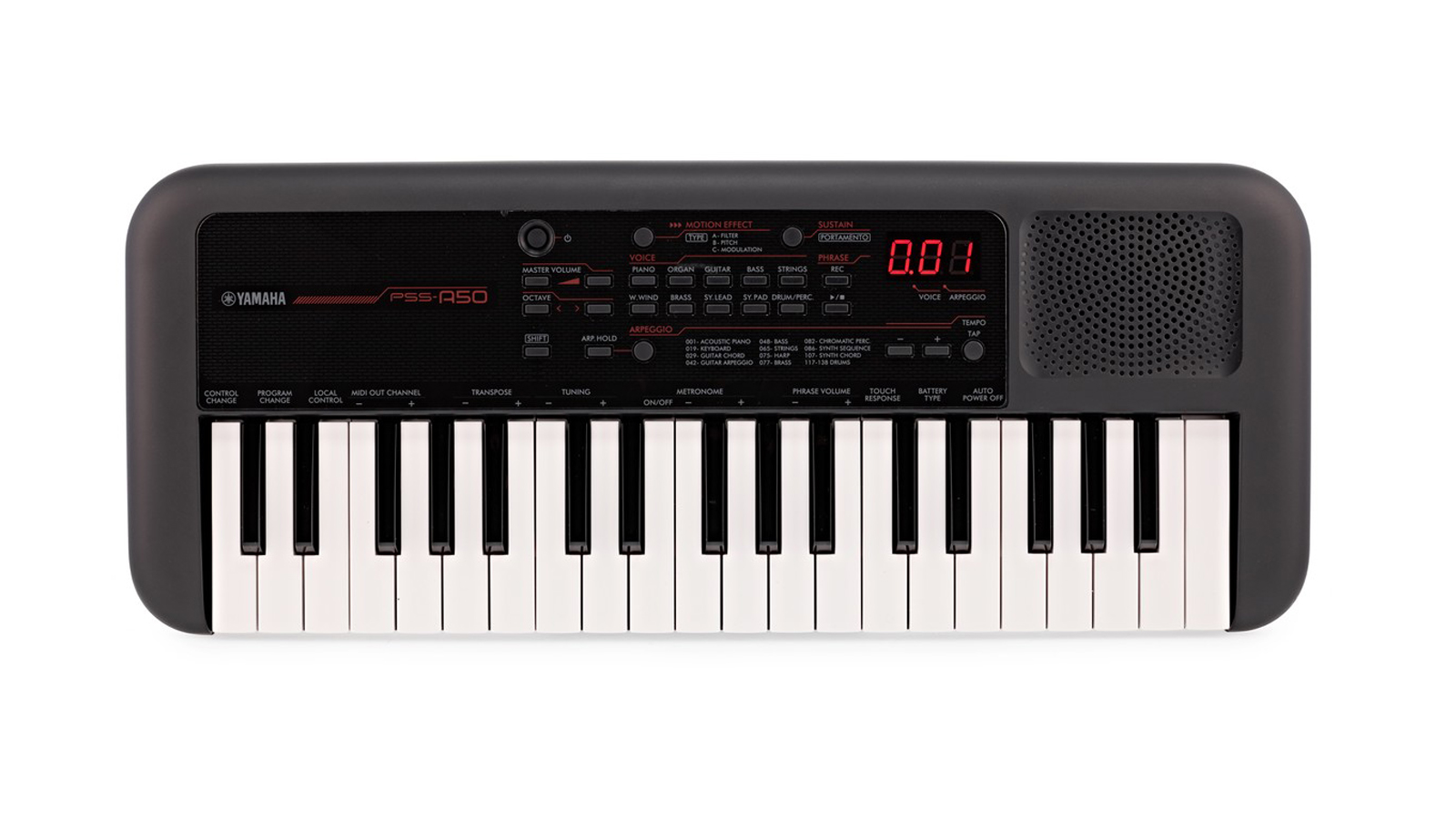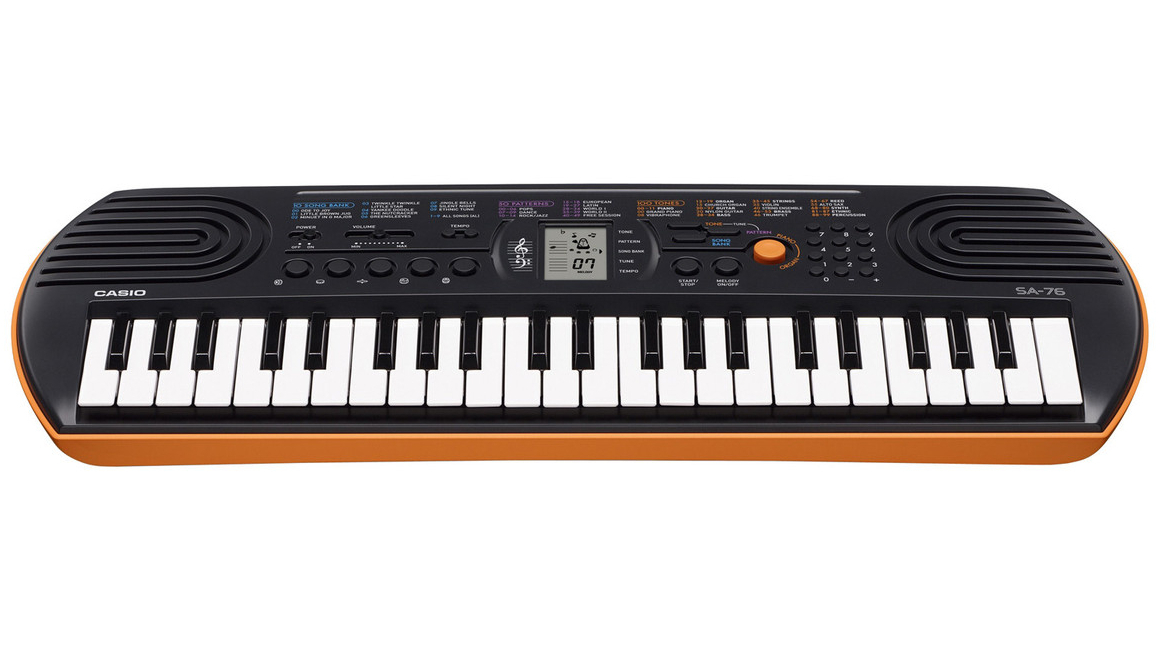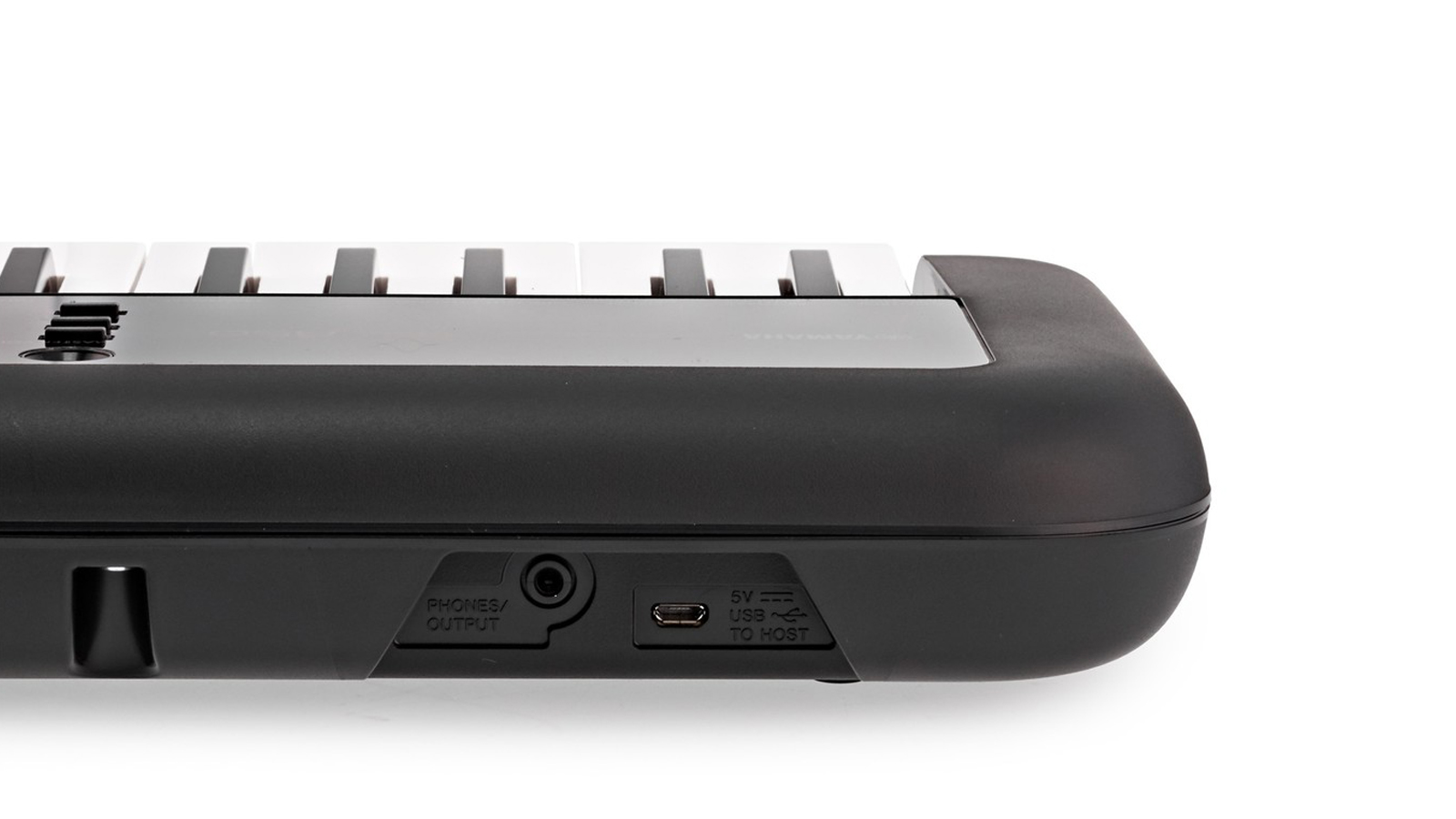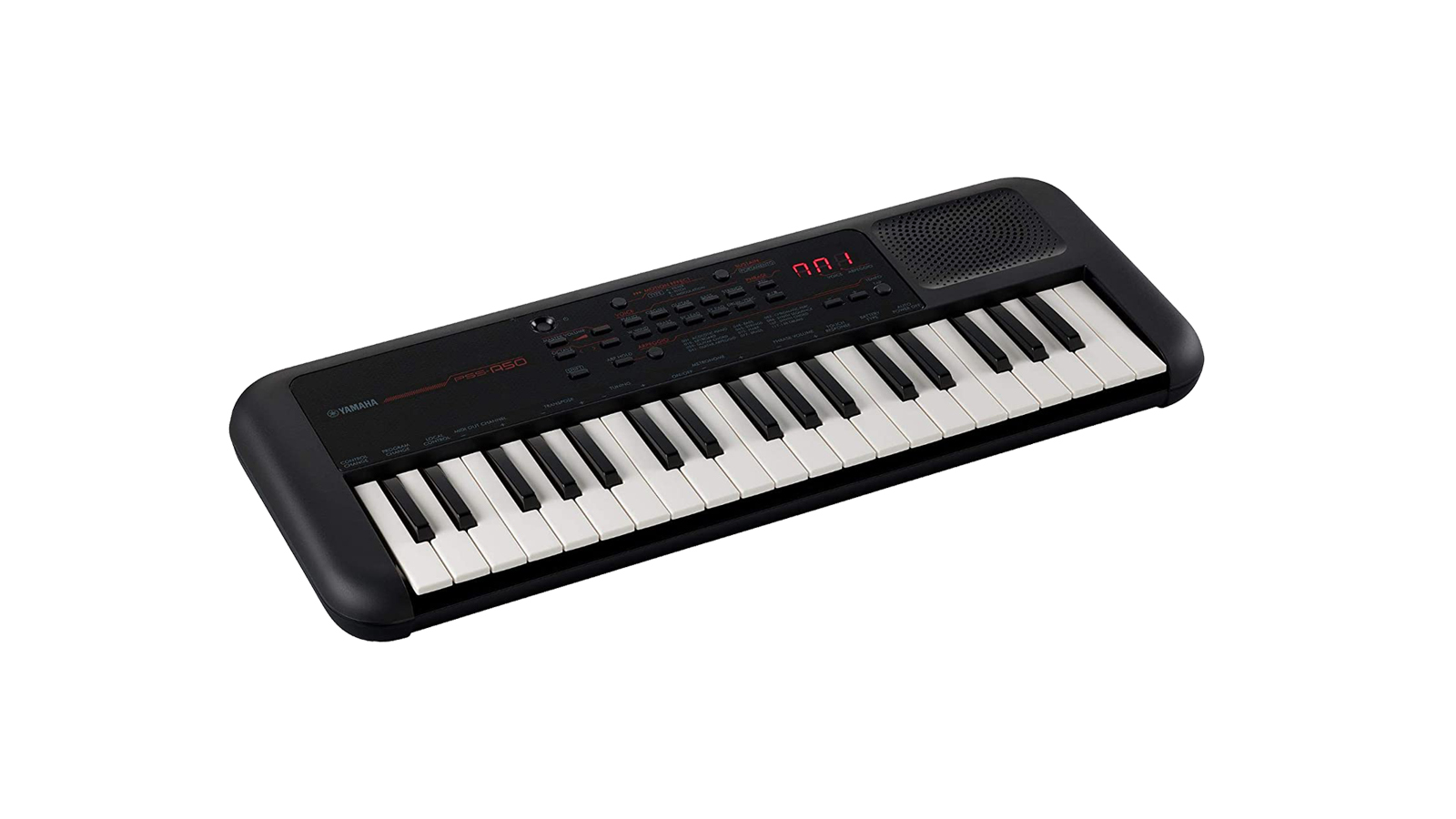MusicRadar Verdict
An entertaining introduction for kids and teenagers to the world of synths, with a velocity sensitive keyboard that can’t be bettered at this price and a smattering of properly usable sounds, the A50 also has a lot to offer as a portable sketchpad for pro musicians.
Pros
- +
Great sounds
- +
Excellent velocity-sensitive keybed
- +
Incredibly portable
- +
Fun motion FX
- +
Battery / USB Bus power
Cons
- -
Single speaker
- -
Not many sounds
- -
Inconsistent volume between instrument sounds
MusicRadar's got your back
Yamaha PSS-A50 review: What is it?
Originally produced between 1980 -1997, Yamaha’s famous PSS range of ‘Portasound’ personal keyboards were renowned for bringing portable music creation to the masses. Cut to today and the Portasound name has been resurrected with a range of three 37-key mini keyboards sporting the PSS model designation, the others being the PSS-E30 Remie and the PSS-F30. Perhaps the most grown-up of the bunch, the A50 appears to have been targeted at making dance music for teenagers, but under the hood there seems to be plenty on offer for all ages, with big-league features such as a velocity-sensitive keyboard with adjustable touch response, portamento, arpeggios, motion effects and a phrase recorder packed into a small body.
With its smart, piano-black finish, the A50 shares the same rounded-corner housing, single built-in speaker and diminutive form factor as its siblings. While the cheaper E30 and F30 are clearly intended as beginner keyboards for young children however, the A50’s more advanced feature set gives it a slightly broader appeal. Of the three, this is the one to go for if preschool, potty training and Pokemon are all a distant memory.
It runs on four AA batteries or USB power and you can also opt to purchase a separate USB power adapter. You do get a USB cable in the box, but there are no batteries included, which seems a little stingy and might cause some consternation on Christmas morning, before the realisation kicks in that you can power the unit from a computer’s USB port or even more usefully, from a mobile phone power bank.
Yamaha PSS-A50 review: Performance & Verdict

Although its toy-like form factor makes it fantastically lightweight, portable and therefore brilliant for kids, the A50 is much more than just a toy. Despite it having fewer sounds than the F30, the motion FX, arpeggios and phrase recorder are this keyboard’s biggest draws. The sounds themselves, derived from the same sound bank found in Yamaha’s more expensive PSR-E series keyboards, are remarkably good quality for a keyboard in this price bracket - they’ve seemingly gone for quality rather than quantity here. There are only four piano sounds for instance - one acoustic and three electric - but they’re all excellent and very usable for an instrument of this stature. The same philosophy goes into the rest of the sound library, which features a sprinkling of hand-picked examples sifted into conventional categories such as Organ, Guitar, Bass, Strings, Woodwind, Brass, Synth Lead, Synth Pad and Drums. The sounds in each category are scrolled through by repeated button presses until the start of the cycle loops back around to the first sound in that set. Scrolling is one-directional, so if you miss your target there’s no option but to keep pressing until you roll back around to it.
Although the front panel is well laid out, the glossy black fascia is a bit of a magnet for dust and fingerprints, with the grey-on-black silk screen text on the front panel a little difficult to read, especially in low light - we feel a brighter colour might have worked better. All information and setting status is conveyed via a cryptic, three-digit, seven-segment LED display, so a read of the manual will eventually be required to decipher messages such as ‘Son’ and ‘PoF’

A Shift button gives you access to all of the settings that employ the keys on the keyboard as switches. Labelled above the keys, these include mainly MIDI-based functions such as control change, program change, local on/off (for when using the A50 as a MIDI controller) transpose, tuning and metronome settings, phrase volume and velocity response.
Once you get the hang of how the front panel operates, it’s time to dive in and experiment with some tunes. There’s a single-track Phrase Recorder for looping and playing back recorded phrases, although we found it quite tricky to figure out how to manipulate the recording process so that there was no gap when the recorded phrase was looped. The keyboard does retain the recorded phrase when powered off, however, and also transmits the recorded data over MIDI, making the A50 a useful sketchpad for capturing spontaneous ideas on the move for polishing up later in a DAW.
Want all the hottest music and gear news, reviews, deals, features and more, direct to your inbox? Sign up here.
In the ‘mess about before opening the manual’ test the A50 performed well - we were able to coax some reasonable results out of the phrase recorder relatively quickly, confirming the fairly intuitive nature of the front panel controls. The user guide itself, when finally consulted, proved to be clear, concise and well thought-out, giving up its secrets with a series of diagrams over just a few pages.

Inherited from the Yamaha Reface series of boutique synths, the keyboard itself is definitely one of the most playable mini-key equipped keybeds we’ve come across, and the excellent velocity sensitivity, with four response levels to choose from, is a real bonus, making it one of the best around at this price.
There’s no input for a sustain pedal, but you do get a Sustain button, which latches on when pressed to add a sustain effect to the current sound. The effectiveness of this varies from sound to sound. This doubles as a portamento switch when used in conjunction with the Shift button. This effect is not editable, but does behave more or less as you’d expect, introducing a swoopy glide between notes that is more pronounced the further apart successive notes are on the keyboard.
Arpeggios
A big selling point of the A50 is the arpeggio feature, which lets you trigger a selection of 117 onboard musical and rhythmic phrases and backing patterns, plus 21 drum patterns, by pressing keys on the keyboard. Although the patterns themselves are well programmed, in practise this feature proved to be a little limited - it’s not really an arpeggiator as such, as all of the patterns are pre-programmed and non-editable. Selecting a new voice automatically selects the default arpeggio for that voice which, although intended to be helpful, can be annoying if you find a pattern you like but just want to change the sound it’s playing.
You can keep the arpeggio going with the arpeggio hold button, after which you can play along using a different sound, but if you want to change chords it’s a two-handed process of holding down the arpeggio hold button while changing chords. And if you want to play a particular pattern with a sound other than that which it’s matched to, that’s a whole other sequence of button pushes. So, unlike the conventional auto-accompaniment that we’re used to with some of Yamaha’s larger models, the arpeggio feature, although good fun, is not quite as flexible as we’d hoped.

Motion FX
Aside from the arpeggios, the motion FX are one of the more entertaining aspects of the A50. The effects are momentary, meaning that they only operate as long as the button is held down, and each effect exhibits its own behaviour. There are ten types of filter effect, and twelve each of the pitch and modulation effects.
The filter effects are mainly resonant filter sweeps, pitch effects range from quick bends up and down to proper slowdowns and speedups, while modulation effects take care of various forms of vibrato and tremolo.
An interesting feature of the A50 that we really weren’t expecting is that the motion FX not only work on the internal sounds, they also transmit over MIDI when using the unit as a MIDI controller. Depending on the synth you’re using it with, this can have some really interesting results - we tested it without any expectation that it would work and were pleasantly surprised when it did.
Yamaha PSS-A50 review: Verdict
Overall, leaning into the ‘my first synth’ territory, Yamaha have pitched the A50 at the teen market pretty well, offering a fun and entertaining taste of some more advanced synthesis features such as portamento, filtering and modulation but without any complex editing involved. For us though, its main appeal is lightweight, portable instant-on access to a few great sounds via a brilliant, velocity-sensitive keybed at an affordable price, all of which, when combined with its capable MIDI functionality, makes the A50 a great viable prospect as a throw-around notepad for songwriters.
Yamaha PSS-A50 review: Hands-on demos
Keen on Keys
BoneZone
Rimmers Music
Yamaha PSS-A50 review: Specifications
- Keys: 37 high quality mini keys
- Touch Sensitivity: Adjustable (Soft / Medium / Hard / Fixed)
- Speaker System: 1 x 8cm, 1.4W
- Presets: 40 voices, 2 Drum kits
- Arpeggios: 138 types
- Polyphony: 32 Notes
- Functions: Motion FX, Sustain, Portamento, Phrase Recorder
- Audio Output: 3.5mm headphone jack
- MIDI I/O: Micro USB
- Power: 4 x AA Batteries, USB bus
- Colour: Black
- Dimensions: 506 (W) x 201 (D) x 54 (H) mm
- Weight: 1.2 kg
- Contact: Yamaha
Dave has been making music with computers since 1988 and his engineering, programming and keyboard-playing has featured on recordings by artists including George Michael, Kylie and Gary Barlow. A music technology writer since 2007, he’s Computer Music’s long-serving songwriting and music theory columnist, iCreate magazine’s resident Logic Pro expert and a regular contributor to MusicRadar and Attack Magazine. He also lectures on synthesis at Leeds Conservatoire of Music and is the author of Avid Pro Tools Basics.

